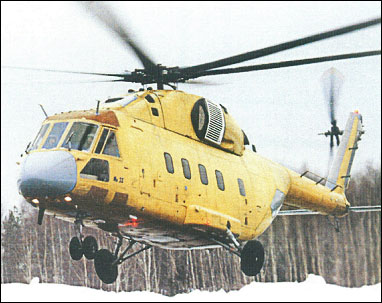
| Mil Mi-38 project |  |
 |

| Mil Mi-38 project |  |
 |
|
TYPE: Medium transport helicopter. PROGRAMME: Design begun in 1983; model shown at 1989 Paris Air Show, when aircraft at mockup stage. Modifications in evidence by 1993 included fixed landing gear with wider track and reduced base. Under December 1992 agreement, Eurocopter will integrate flight deck, avionics and passenger systems, and will adapt Mi-38 for international market; Euromil joint stock company established September 1994 to advance collaboration, adding Kazan production plant (as main manufacturing and final assembly centre); funding for Euromil granted in October 1994 by European Bank for Reconstruction and Development. Sextant and Pratt & Whitney Canada added as risk-sharing parties for avionics and engine. Funding by Russian Ministry for Defence Industries 1996. Mi-38 rotor blades began test flying on an Mi-17 in early 2001. By 1997, Euromil was anticipating first flight in 1999 and start of production two years later, following FAR Pt 29 certification. However, contracts for completion of demonstrator not signed until 18 August 1999, following unilateral decision of Euromil board in December 1998 to launch programme and fly demonstrator at Kazan in 2001, although this subsequently slipped to 2002 and then to mid-2003. Demonstrator (PT-1) is third airframe, following test articles at Mil Moscow and Kazan. Four further prototypes to follow, including two for static testing. CUSTOMERS: Predicted sales of 200 in CIS, plus 100 exports. COSTS: Estimated development cost (2001) US$500 million; unit cost US$12 million to US$16 million for export; US$11 million in Russian Federation (2002). DESIGN FEATURES: Planned as replacement for Mi-8/17 series. Western engines optional. Conventional pod and boom configuration; power plant above cabin; six-blade main rotor with considerable non-linear twist and swept tips; main rotor has hydraulic drag dampers: single lubrication point, at driveshaft; rotor brake standard; Krasny Oktyabr transmission, comprising main, intermediate and tail gearboxes and tail rotor drive shaft; engine input 19,017 rpm; two independent two-blade tail rotors, set as narrow X on same shaft; sweptback fin/tail rotor mounting; small horizontal stabiliser; for day/night operation over temperature range -60 to +50°C FLYING CONTROLS: Fly-by-wire, with manual back-up. STRUCTURE: Composites main and tail rotors by Kazan; low-profile titanium main rotor head, with elastomeric bearings, built by Stupino; fuselage, mainly composites, built by Kazan. LANDING GEAR: Fixed tricycle type: single wheel on each main unit; oleo-pneumatic shock absorbers; twin, self-centring nosewheels; low-pressure tyres; optional pontoons for emergency use in overwater missions. Main tyres 950mm diameter, pressure 5.88 bar; nose tyres 600mm diameter, pressure 4.90 bar. POWER PLANT: Those helicopters for CIS customers powered by two Klimov TVA-3000 (TV7-117 derivative) turboshafts, each rated at 1,838kW for T-O; single-engine rating 2,610kW and transmission rated for same power. Demonstrator to have two 2,461kW P&WC PW127 rurboshafts, which are also available, in PW127T/S form, as an option for Western customers. Power plant above cabin, to rear of main reduction gear; air intakes and filters in sides of cowling. Bag fuel tanks beneath floor of main cabin; provision for external auxiliary fuel tanks. Liquid petroleum gas fuel planned as alternative to aviation kerosene. ACCOMMODATION: Crew of two on flight deck, separated from main cabin by compartment for majority of avionics; single-pilot operation possible for cargo missions. Lightweight seats for 30 passengers as alternative to unobstructed hold for 5,000kg freight. Ambulance and air survey versions planned. Passenger door, forward, port; freight door, forward, starboard; cargo ramp at rear; hatch in cabin floor, under main rotor driveshaft, for tactical/emergency cargo airdrop and for cargo sling attachment; optional windows for survey cameras in place of hatch. Provision for hoist over portside door, remotely controlled, hydraulically actuated rear cargo ramp, powered hoist on overhead rails in cabin, and roller conveyor system in cabin floor and ramp. SYSTEMS: Air conditioning by compressor bleed air, or APU on ground, maintains temperature of not more than 25°C on flight deck in outside temperature of 40°C, and not less than 15°C on flight deck and in main cabin in outside temperature of -50°C. Three independent hydraulic systems; any one able to maintain control of helicopter in emergency. Electrical system has three independent generators, two at 12kW DC and one 60kW AC; optional fourth generator 40 or 60kW AC; two batteries; electric rotor blade de-icing, main and tail. Independent fuel system for each engine, with automatic crossfeed; forward part of cowling houses VD-100 APU, hydraulic, air conditioning, electrical and other system components. AVIONICS: Sextant equipment in export aircraft. Jane's All the World's Aircraft, 2004-2005
|